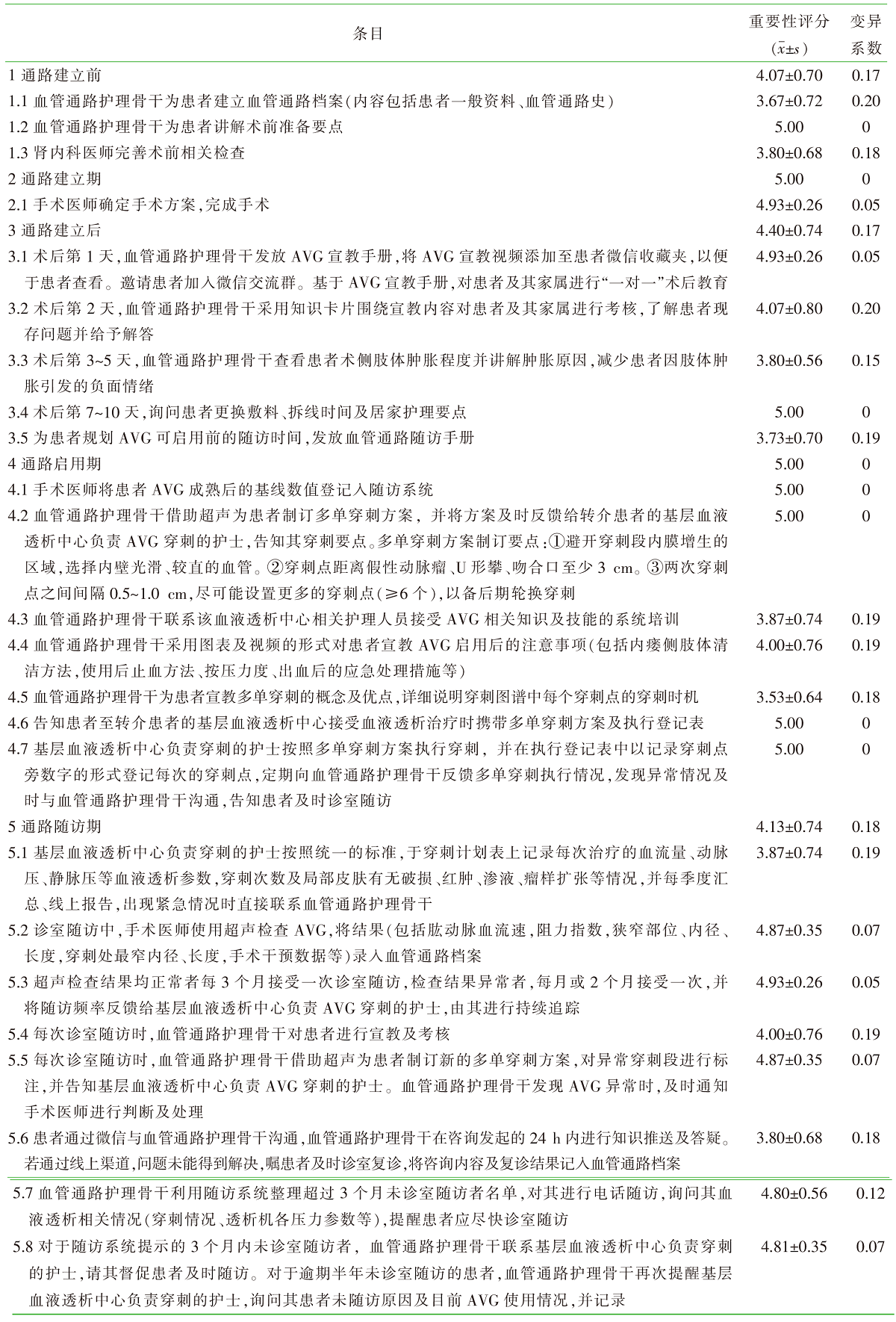| [1] |
Zhang LX, Wang F, Wang L, et al. Prevalence of chronic kidney disease in China:a cross-sectional survey[J]. Lancet, 2012, 379(9818):815-822.
|
| [2] |
Zhang LX, Zhao MH, Zuo L, et al. China kidney disease network(CK-NET) 2016 annual data report[J]. Kidney Int Suppl, 2020, 10(2):e97-e185.
|
| [3] |
姜惠丽. 人造血管移植物动静脉内瘘的使用及维护管理现状[J]. 齐鲁护理杂志, 2019, 25(3):11-14.
|
| [4] |
Allon M. Arteriovenous grafts:much maligned but in need of reconsideration[J]. Semin Dial, 2017, 30(2):125-133.
|
| [5] |
王超, 傅麒宁, 冉坤, 等. 158例次人工血管动静脉内瘘术后并发症与长期通畅率[J/OL]. 中国血管外科杂志(电子版), 2017, 9(1):15-20.
|
|
Wang C, Fu QN, Ran K, et al. The long-term patency and postoperative complications of arteriovenous graft[J/OL]. Chin J Vasc Surg Electron Version, 2017, 9(1):15-20.
|
| [6] |
Coentrão L, Van Biesen W, Nistor I, et al. Preferred haemodia-lysis vascular access for diabetic chronic kidney disease patients:a systematic literature review[J]. J Vasc Access, 2015, 16(4):259-264.
doi: 10.5301/jva.5000323
pmid: 25656252
|
| [7] |
方继红, 武凤芹, 李镇宇, 等. 儿童创伤性疼痛链式管理方案的制订及应用[J]. 中华护理杂志, 2020, 55(8):1154-1158.
doi: 10.3761/j.issn.0254-1769.2020.08.005
|
|
Fang JH, Wu FQ, Li ZY, et al. Formulation and clinical practice of a chain management scheme of traumatic pain in children[J]. Chin J Nurs, 2020, 55(8):1154-1158.
doi: 10.3761/j.issn.0254-1769.2020.08.005
|
| [8] |
张晓雅. 个案管理在血液透析患者自体动静脉内痿护理中的应用研究[D]. 郑州: 郑州大学, 2021.
|
|
Zhang XY. Effects of case management model in autogenous arteriovenous fistula nursing of hemodialysis patients[D]. Zheng-zhou: Zhengzhou University, 2021.
|
| [9] |
王李胜, 张仲华, 杨建国, 等. 血液净化中心血管通路护士岗位设立与实践[J]. 护理学报, 2021, 28(19):30-32.
|
| [10] |
胡琳莉, 王秋琴, 宋玉磊, 等. 基于德尔菲法构建中医护理人才分层评价指标体系[J]. 护理研究, 2021, 35(1):7-14.
|
|
Hu LL, Wang QQ, Song YL, et al. Construction of hierarchical evaluation index system of TCM nursing talents based on Delphi method[J]. Chin Nurs Res, 2021, 35(1):7-14.
|
| [11] |
European Society for Vascular Surgery(ESVS). Guidelines for vascular access[J]. Eur J Vasc Endovasc Surg, 2018, 55(6):757-818.
|
| [12] |
Sidawy AN, Gray R, Besarab A, et al. Recommended standards for reports dealing with arteriovenous hemodialysis accesses[J]. J Vasc Surg, 2002, 35(3):603-610.
doi: 10.1067/mva.2002.122025
pmid: 11877717
|
| [13] |
路潜, 谢一萍, 苏春燕, 等. 腹膜透析病人随访依从性及生存状况研究[J]. 中国护理管理, 2010, 10(3):42-44.
|
|
Lu Q, Xie YP, Su CY, et al. Follow-up compliance and out-comes among peritoneal dialysis patients[J]. Chin Nurs Manag, 2010, 10(3):42-44.
|
| [14] |
王宛. 探讨门诊随访率对腹膜透析患者生存状况的影响[D]. 银川: 宁夏医科大学, 2015.
|
|
Wang W. The influence of follow-up rate to outcomes among peritoneal dialysis patients[D]. Yinchuan: Ningxia Medical University, 2015.
|
| [15] |
高菊林, 梁珊珊, 杜晶晶, 等. B超下画图计划绳梯穿刺在动静脉内瘘患者中的应用与分析[J]. 中国血液净化, 2018, 17(5):356-359.
|
|
Gao JL, Liang SS, Du JJ, et al. Application of rope ladder puncture under the guidance of color Doppler ultrasonography in hemodialysis patients with arteriovenous fistula[J]. Chin J Blood Purif, 2018, 17(5):356-359.
|
| [16] |
陈香美. 血液净化标准操作规程-2021[M]. 北京: 人民卫生出版社, 2021.
|
| [17] |
Lok CE, Davidson I. Optimal choice of dialysis access for chronic kidney disease patients:developing a life plan for dialysis access[J]. Semin Nephrol, 2012, 32(6):530-537.
|
| [18] |
王沛, 刘章锁. “以患者为中心”整合诊疗模式在血液透析血管通路临床实践中的应用[J]. 中华肾脏病杂志, 2023, 39(5):325-329.
doi: 10.3760/cma.j.cn441217-20221220-01227
|
|
Wang P, Liu ZS. Establishment of integrative medicine with patient first model in the clinical practice of hemodialysis access[J]. Chin J Nephrol, 2023, 39(5):325-329.
doi: 10.3760/cma.j.cn441217-20221220-01227
|
| [19] |
岳晓红, 梁献慧, 刘亚敏, 等. 医联体分级共管模式对血液透析患者移植物内瘘通畅的影响[J]. 中华肾脏病杂志, 2023, 39(6):438-445.
doi: 10.3760/cma.j.cn441217-20221124-01140
|
|
Yue XH, Liang XH, Liu YM, et al. Effects of hierarchical management based on medical alliances on patency of arteriovenous graft in hemodialysis patients[J]. Chin J Nephrol, 2023, 39(6):438-445.
doi: 10.3760/cma.j.cn441217-20221124-01140
|
| [20] |
Chen J, Zhou M, Zeng K, et al. The risk factors of autogenous arteriovenous fistula dysfunction in maintenance hemodialysis patients and the curative effect of personalized nursing[J]. Am J Transl Res, 2021, 13(5):5107-5116.
pmid: 34150099
|
| [21] |
雷雨田. 血管通路协调员主导的自体动静脉内瘘多学科管理方案的构建与应用[D]. 郑州: 郑州大学, 2022.
|
|
Lei YT. Construction and application of multidisciplinary care scheme for hemodialysis patients led by the vascular access coordinator[D]. Zhengzhou: Zhengzhou University, 2022.
|
| [22] |
周雅婷, 张柠, 辛园园, 等. 基于管理协同理论的国内外医疗机构上下联动工作机制分析[J]. 中国医院, 2021, 25(2):1-4.
|
|
Zhou YT, Zhang N, Xin YY, et al. Research on the vertical linkage mechanism of medical and health institutions in China and abroad based on Synergistic Management Theory[J]. Chin Hosp, 2021, 25(2):1-4.
|
| [23] |
张彬彬, 魏丽丽, 崔莉, 等. 血液透析患者移植物动静脉内瘘并发症预防与管理的证据总结[J]. 中国护理管理, 2024, 24(1):95-101.
|
|
Zhang BB, Wei LL, Cui L, et al. Evidence summary for prevention and management of complications of arteriovenous graft in hemodialysis patients[J]. Chin Nurs Manag, 2024, 24(1):95-101.
|



